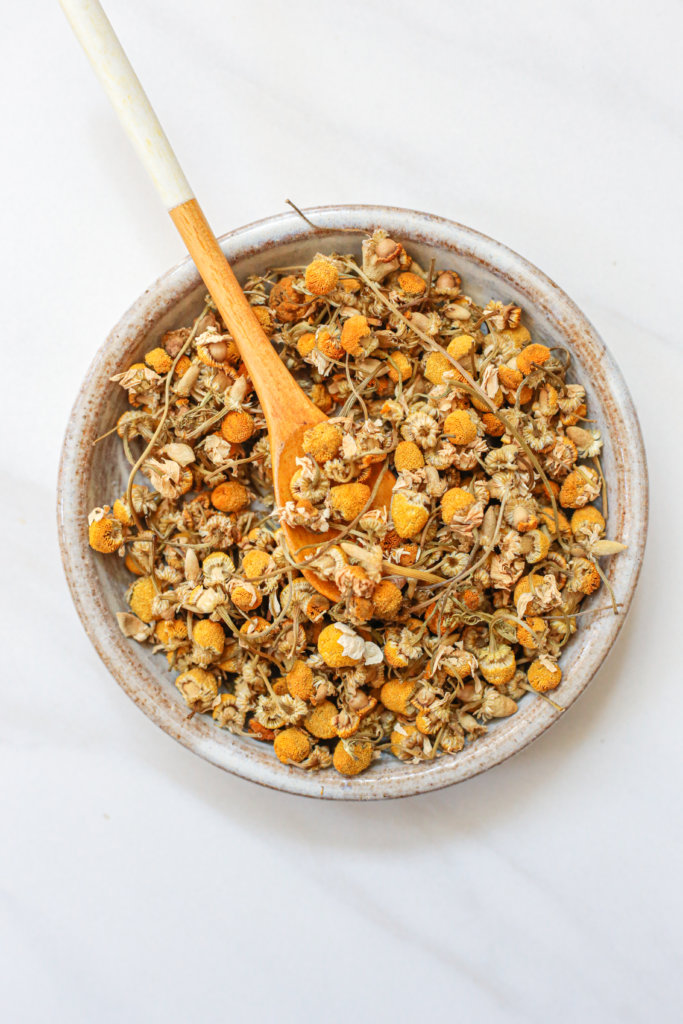Flowers are so nice to add to your skincare, they draw you right in elevate the way you feel. Flowers bring beauty, healing and sweet aromatics.
In this article we’ll look flowers that are not only look beautiful blended into your recipes, but that also have therapeutic benefits too. I’ve written some of the most common flowers used for the skin, and their benefits.
And then I’ll give you some tips for how to preserve fresh flowers, to enjoy all year long.
Flowers for Skincare

Rose: Astringent
Has an astringent action that helps to tighten and tone skin. Rose helps the tissues of the skin, hold in hydration. Considered a heart-tonic, rose is an aromatic nervine that soothes anxiety and uplifts a heavy heart.
Chamomile: Soothing
Used for soothing inflammation in the skin, calming redness and rashes. Very healing, but also very gentle – Chamomile has long been used to soothe babies. Add chamomile to baths or infuse in oil to apply on the skin.
Jasmine: Aphrodisiac
With its intoxicating scent, jasmine has an effect on the mood, and mindset. It creates feelings of euphoria.
Citrus blossoms: Uplifting
Lemon, orange, and lime flower blossoms have an uplifting quality, used to help lift the spirits and ease tension. Its aromatherapy can benefit baths, herbal steam treatments, and herbal body oils.
Lavender: Cleansing
Most notably known for its calming and soothing effect, lavender flowers are also incredibly antimicrobial, a great herb for preventing and healing breakouts. Lavender hydrosol is great to mist and clean the skin, lavender infused oil is a great facial cleanser.
Passionflower: Calming
A calming herb, used to help promote restful sleep – the flowers and leaves also have a calming and soothing effect on the skin. You can use them in the bath, or infuse them into oil for a full body treatment before bed.
Calendula: Overall Health
The flowers have an affinity for the skin, and it’s one of the most popular herbs used in skincare. Much of the medicine comes from the resins in the flower head, which are mostly found in the green part that hold the petals. Infuse whole flowers heads in oil to use on your skin, for healing breakouts and wounds, and for nourishing healthy skin overall.
Yarrow: Healing
The flowers are used mainly in healing remedies, to heal bruises, wounds and even to help stop bleeding of cuts and scrapes.
Dandelion: Detoxifying
The leaves are very bitter (the root more so), which has a cleansing, detoxifying action. The petals are a little sweet, indicating a nutritive quality.
Daisy: Healing Also known as “poor man’s arnica”, daisies can be infused in oil for a bruise salve or remedy. Used as poultice, it can be applied directly on the skin to help with healing. The flower has mucilage, which is very soothing to dry, inflamed tissues.
Elderflower:
All parts of the elder are medicinal, used for different things. The flowers contain mucilage (moistening and soothing), flavonoids (antioxidants) and tannins (astringent, tightening toning action). The flowers can be infused in honey, to enjoy as food. Or to use as a facial mask, to clear breakouts, soothe and protect your skin. The leaves can be infused in oil, to help with bruises (combined with daisy flowers). Rub the fresh leaf all over to deter insects.
Violet: Cooling
Both the flowers and leaves are used in skincare preparations, although mostly the leaves. Violets are mucilage rich, very cooling and calming for red-hot inflammation. The flowers can be dried and blended in bath salts, or pressed and used to decorate off bath bombs.
Sourcing flowers for skincare

Grow: When you grow your own flowering herbs, you have access to the freshest blooms, really potent and fragrant. And, for many people, growing herbs brings so much joy, and it part of the healing that nature provides.
Forage: You can also forage wild blooms. Sign up for weed-walk classes in your area, its a great way to learn about what grows around you, how to identify it, and how to harvest responsibly.
Purchase: You can also purchase a lot of dried flowers from online herb stores, like chamomile, lavender, calendula. Some of my favorite online stores in the US are:
But its also a good idea to search online for “herb store” or “apothecary near me” – you might be happily surprised and find a local shop that you can support.
Also, if you have a good source of herbal tea – a little tea shop or even in supermarkets – you can often find rose tea, lavender, chamomile – to use in your recipes. For years when I first started making natural skincare, my only access to herbs was from the supermarket!
Preserving fresh flowers

Drying Flowers: One of the simplest ways to preserve fresh blooms all year long is to dehydrate them.
I use a dehydrator at home, I can set it very low to gently dry the flowers easily. Here’s an article on the dehydrator that I use.
If you live in a dry environment (not humid) you could most likely air-dry your herbs using an airing rack, like this.
Pressing flowers: You can also press flowers, all you need is card board, and something heavy like a cast iron pan or a stack of heavy books.


